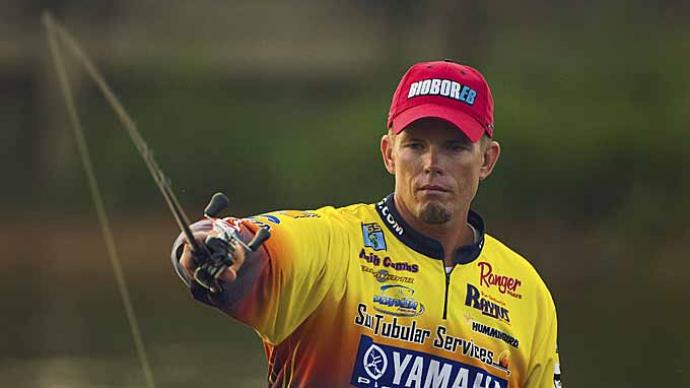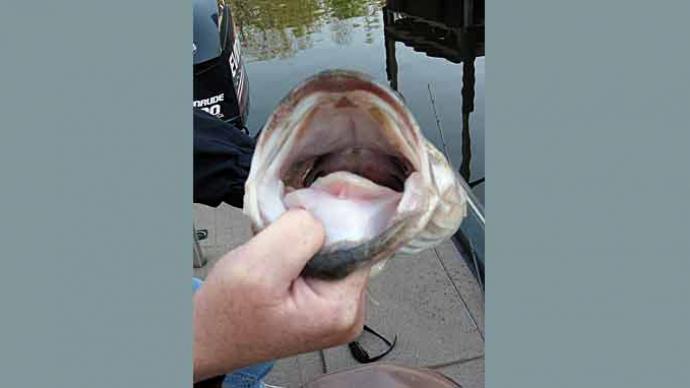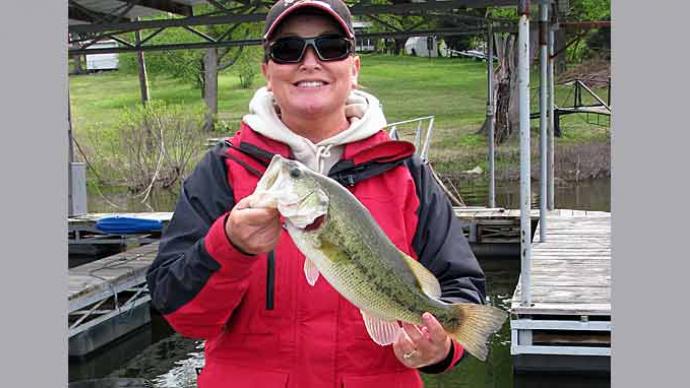
How often have you heard a fisherman complain, "I'll fish when it's hot or cold, but I hate fishing in the wind!" I am not one of those people. On the contrary, I have trained myself to look forward to windy days. There are several reasons for this.
I believe the wind can and does energize a fishery. It makes the baitfish more active because the wind will move their food supply around. The bass become more active because the baitfish have become more active. The wind will also actually position the fish. As a result, they become somewhat more predictable.
Competition for your favorite honey hole will be less on a windy day. And, on most lakes on windy days, the majority of fishermen are not where the majority of the active fish are. A careful analysis of the effects of wind on a fishery and a thorough understanding of it will allow you to utilize your time spent at the lake better. The wind is our friend. Your catching will improve when you learn to use rather than fight it.
Wind and waves break up the surface, decreasing visibility by reducing light penetration. It also stirs up the sediment and life in the water. This in itself will make the bass more aggressive. By nature, bass will take advantage of any opportunity.
A breeze will tend to make the fish less spooky, especially in clear water. It doesn't necessarily make them feed, but I feel the conditions are more conducive to it as light penetration decreases. Continual wind pounding on a stretch of the bank will also create a mud line. The bass will also use this added concealment in certain instances, except in a lake with normally off-colored water. Under these conditions, I have rarely found the bass in the mud line.
Directional winds do create current. However, most anglers overestimate the strength of wind-induced currents. Research shows strong winds over open water flow along the surface at about two percent of wind speed. Weaker winds move water at only about one percent of wind speed. So, a wind blowing at 30 mph creates a 0.5 mph current, while a wind blowing at 15 mph generates a 0.1 mph current. Wind-generated currents are less critical in small reservoirs, and coves usually don't have detectable wind currents.
Current, however large or small, will position fish in specific ways. The fish will face the current, or wind, 99 percent of the time. If you are not casting into the wind, change your direction. The percentage of bass that will strike a lure presented to them from behind is markedly less than that of the one in its face. If at all possible, work a shoreline into the wind.
Wind currents that last several days may concentrate floating plankton near downwind shores. Such a concentration sometimes attracts baitfish and prey that may stimulate bass activity. So some of the best concentrations of bass on a windy day will be on the windward side. But, again, the key is to look for baitfish. You know the bass will be nearby when you throw a spinnerbait shallow and see the baitfish scatter.
Consistent winds will also push the warm surface layer downwind while cooler water is drawn to the upwind side. If the temperature is critical, prevailing wind directions can help anglers locate warmer (downwind) or cooler (upwind) surface water. Winds lasting only a few hours create no noticeable currents and affect fishing only by creating ripples and waves that change subsurface light.
| Stay in contact with your bait is of utmost importance under these conditions. |
Waves produce background noise that may interfere with the hearing and lateral-line senses of the bass. Many anglers use noisy topwater lures such as Pop R's and buzzbaits when fishing in the wind. Take this aspect of the picture into consideration when choosing your baits. You don't necessarily have to use loud topwater baits but choose baits that move a lot of water and have plenty of flash and vibration.
Your equipment needs to be in top-notch condition for a day on the lake in the wind. All accessories mounted to the boat should be checked for security. Start with the trolling motor attachment. A weathered tie-down strap has left many unprepared anglers with a broken-off trolling motor hanging by the cables. Trolling motors are expensive at the marina on tournament weekend. Batteries should be verified as fully charged. When working windblown shorelines into the prevailing wind, you need all the power those reliable/durable batteries will muster. All loose items should be stowed in their compartments or left at the house. Many nets and a few tackle boxes have bounced out on the bottom of the lake. Everyone on board needs to have a life jacket on and the boat operator hooked to an operational kill switch. Know the operational limitations of your equipment. Do not expose yourself or your passengers to unnecessary dangers.
Your tackle needs to be up to par as well. Make sure your reels are fully spooled with line. An improperly spooled reel will decrease casting distance. You will likely be casting into the wind, and all the distance you can get is necessary. It's also a good idea to tighten down on the spool adjustment of your reel. This will decrease casting distance but cause substantially fewer "professional overruns." Another good tip is to downsize the line diameter. Although the lesser visibility of the water should allow you to use a heavier line, the larger diameter of the heavier line has more drag in the wind and moving water. Downsizing your monofilament will give you more stretch, so adjust your reel accordingly and back off the drag a bit. A braided-type line will accomplish all goals in this scenario smaller diameter and little or no stretch.
Before discussing baits and strategies, I want to touch on the importance of the current weather conditions, disregarding the wind. The wind will position the fish, causing them to act and behave in specific ways. The lifecycle pattern (i.e., pre-spawn, post-spawn, etc.) still takes priority, combined with the seasonal patterning we all go by. The wind adds "atmosphere." During pre-spawn, a windy bluebird day after a cold front will still be tough fishing. On the other hand, a windy day, or several windy days in a row, after or during several days of stable weather could be a bonanza day. Consider these basic patterns as guidelines first, then deal with the atmosphere.
On windy days, I look for windblown shorelines. I like the wind at an angle to the shoreline to create a bit of current. I will start at the downwind end of the bank and work into the wind if I can. This can be extremely difficult, depending on the wind speed. Sometimes, the wind is too strong to do this, and you must work with the wind. Still, you can keep your boat positioned into the wind, and cast into the wind, just traveling backward in the boat down the shore.
A spinnerbait is my first choice when fishing a windblown shoreline. I like tandem willow-leaf blades and will adjust the color of the blades and skirting as the water conditions vary. This bait has all of the characteristics necessary to entice a strike. Flash and vibration are necessities. White or chartreuse are my primary choices under most conditions. As the wind strengthens, you may also change to heavier baits and different blade combinations. Stay in contact with your bait is of utmost importance under these conditions. You can fish it reasonably quickly, which is a help because it's not always easy to control your boat in high winds and fish a "feel" bait like a worm or jig simultaneously. They will also draw the strikes, but detecting them is much more difficult.
My second choice for the windy bank pattern is a crankbait. It will be big and heavy enough to cast into the wind and be a "contact" bait. A 3/4-ounce Rat-L-Trap is an excellent choice and is probably one of the all-time best baits for picking off active fish. Don't forget we're looking for the fish the wind made more active. Shad colors and crawdad or firetiger will all produce as they imitate the baitfish and creatures that may have been positioned or dislodged by the wind.
I will take for and fish the windiest banks I can find when working this pattern. Covering water is the way to find fish. The wind will position the fish, and it will position them the same all over the lake in relation to the wind and the structure. Pay particular attention to the structure associated with these windy shorelines. A point or small cut is an excellent ambush point if the wind blows across it just right. Take note if you caught the fish up or downwind of the point or cut, and just how far from it. Try the same type of place on the next shoreline. You will be surprised at the consistency of the bass. Cover the water and look for baitfish.
| The wind is a factor in fishing that can be used to your advantage. |
Another technique becoming more and more popular is loosely termed dragging. Drift fishing would more accurately describe the technique, but whichever term is used, it is a highly effective way of dealing with the wind successfully. I see this used more when fishing main-lake structures, but it can also be an effective way to work a shoreline so long as you pay strict attention to how you present the bait (i.e., cast upwind, retrieve downwind).
Main-lake structure/cover sometimes constricts the current or flow created by the wind, speeding it up. This often will attract baitfish and bass. A hump rising within a few feet of the surface may compress and accelerate wind-driven currents enough to stimulate feeding behavior similar to river-run bass. Again, look for "sweet spots" in that structure. Note if the fish came downwind, behind the hump, or upwind. Bass often move several hundred yards while feeding on baitfish, moving with the wind.
When fishing this main-lake structure/cover, make sure to have marker buoys on board, and do not be bashful about using them. Mark the structure/cover you are fishing. It will help you visualize the "lay of the land." Mark any abnormalities of that structure and any fish you may catch. You can make your drifts more productive by eliminating the unproductive water. Avoid making two-mile drags. Work precise areas. Use of a windsock while drift fishing will slow your speed and keep your bait in the strike zone longer. The windsock will also give you more directional control in the wind. However, I cannot tell you it will make you catch more fish. It may, on certain days, and may not on others. I have caught numbers of fish dragging main-lake structures without a drift sock and have also been skunked. What gives? I like that using the sock will keep you over the structure for a longer period than if you weren't using it. That in itself will increase your odds.
When drift fishing, you also need to be using a contact bait. A Carolina-rigged bait is a good choice. There are times to use a 10-inch Power Worm (pre-spawn), and there are times to use a French fry (post-spawn or summer). I will use a 3/4- or 1-ounce weight on a really windy day. This will allow you to stay in contact with the bait. A big spinnerbait, at least 3/4- ounce, will also be effective. Either of these baits will come through cover very well, and that is important in the wind. It is hard, and most times impossible, to go back and free a hung-up bait.
Unfortunately, we must constantly deal with changing weather conditions. Rarely do I get to pick the fair weather days for a fishing trip. One day can be a nice warm, and pleasant day, and the next cool and windy. As the old saying goes, one can be an excellent day for fishing and the other a great day for the fish. Which day is the great day for the fisherman? That depends on the fisherman. Most fishermen will say a nice, warm, and pleasant day is a great day to be fishing. Without dispute, it certainly is. However, if approached correctly, the latter day can be great for catching. When the wind starts blowing, most fishermen head for the protective cover of a hidden cove, go to another lake, or go home. Unfortunately, these fishermen will miss some of the better fish.
To consistently catch fish, a fisherman needs to be adept at fishing in all weather conditions, including windy days.




